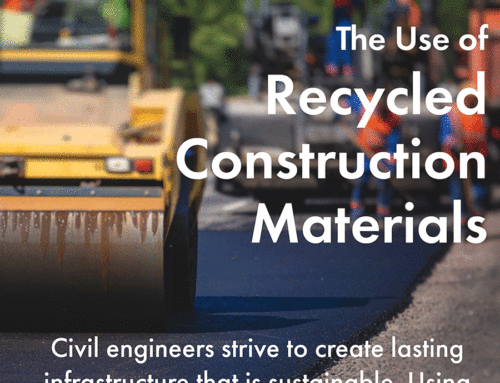
Success begins from the ground up. Since this is true for most projects in the built environment, what about the ground itself? Shouldn’t the land be the first thing measured, assessed, drawn and studied? Whether the project is a recreation trail, residence, roadway, industrial property, subdivision, commercial property, school campus, etc., a completed survey of the land will make any project easier to visualize and see to completion.
So, what is on a survey that makes it such an important document? In this article, we will share the basics of land surveying, beginning with an overview of the process and what information is typically contained within a survey. Then, we will review the benefits of having a survey in regards to building projects and developing land.
How Does Land Surveying Work?
There are traditional methods as well as new digital tools for collecting survey data, which can then be used to create survey maps which describe the land’s surface and all key features therein. The initial survey practices reach back several centuries to pioneers of the profession; surveyors who subdivided fertile land around the River Nile. Since then, the practice and tools have evolved tremendously. Today, land surveyors can take advantage of artificial intelligence, aircraft, drones and many other sophisticated tools to collect data about a given piece of land.
The practice is inseparable from civil engineering and construction processes as it determines distances, angles and potential barriers between different points on land. Civil engineers have used land surveying for various needs, ranging from establishing boundary ownership to deciding the ideal locations to construct roads, rail, dams, retention pools, buildings and other structures within the built environment.
Readily Available GIS is not always accurate.
With the advent of public access to GIS (Geographic Information Systems), people are downloading information off the internet, and assuming the data is accurate, when in fact, property lines and datapoints can be off by 50 feet or more. Citing buildings and structures with inaccurate land data can become very costly if the structures need to be removed for violating setbacks, property lines, easements, etc. due to “free GIS” data. Having a PLS (Professional Land Surveyor) accurately mark your property based on established data points, survey monuments, and other existing historic markers is one of the best investments a land owner can make.
Land surveying is classified into three basic categories: Standard Survey, Engineering Survey and Informational Survey. However, there are several subdivisions within these categories and other classifications that include airplanes and geodetic surveys. Popular types of land surveying include:
- ALTA/ACMS survey – Comprehensive survey covering all property features and characteristics, including existing improvements relative to boundaries found in the land’s title deed.
- Boundary survey – As the name suggests, this survey seeks to identify all boundary lines and corners of a particular land parcel.
- Construction survey – Involves staking out the walls, buildings, roads, utilities and other structures on the parcel of land and may include both vertical and horizontal grading.
- Location survey – This survey is similar to a boundary survey. However, it provides more information concerning the location of features on the property.
- Site planning survey – Combines boundary and topographic survey used to plan design improvements before construction. It is a requirement when applying for development permits.
- Subdivision survey – Mainly used to divide the property into smaller lots and estates. It is also requested when designing drainage and streets.
- Topographic survey – Locates topographical and human-made structures and features on the piece of land, including buildings, elevations, local agencies and many more.
“By having a land survey crew within Keck + Wood allows our projects to continue ahead, even if there is an unforeseen site problem. We get detailed, documented conditions & solutions immediately.” Matt Crawford, PE – Vice President – Community Development
What Can a Survey Tell Us?
A survey is essentially a “Feasibility Study of the Land.” Once there is a complete story of the property, then planning can begin. To develop the base map for development or recreation, the KW team would include, at a minimum the following information:
- Property Lines – the true extent of the land to be studied. Beneficial for current or future property disputes.
- Property Limitations – most land has limitations, whether its building setbacks, easements, encroachments, concealed conditions, overhead and underground utilities, and any other limitations on site or within any documentation.
- Sizing of the Property – what you can do with it, what can you fit? Where can you place structures.
- Topographical – changes in land elevations, A topographical map of the property can help identify the relationships between the low and high spots, perfect for placing retention ponds.
There are several land surveying projects civil engineering consultants handle. Any finished building or road construction is evidence of land surveying. However, projects can be distinguished as community, municipal, commercial and residential. Utility company projects are also a familiar distinction. Some of Keck + Wood’s more popular land surveying projects include:
- Transportation planning
- State and local roads construction, including intersections and roundabouts
- Water collection, treatment and distribution
- Natural gas distribution
- Parks and recreation
- Storm and floodwater management
- Asset management
- ADA transition plans
- Educational projects
- Property dispute settlements
“Surveying can sometimes be compared to an archaeological dig. With a geographic area brimming with history, sometimes it’s a challenge to run through the markers and land monuments of yesterday, to find the datapoints of today.” Ed Phelps, PLS – K+W Survey Manager
Why is a Survey Important for Building?
Land surveying has many uses, ranging from establishing property boundaries for ownership to providing crucial land information required to determine where to install roads, rails and buildings. Surveying has been used to settle land disputes and enables the generation of maps and reports describing the piece of land (location and features). Popular land surveying uses include:
- Assessing construction sites and providing the initial survey and environmental impact assessment of the project before construction work begins. This includes charting all the features of a site using exact coordinates.
- Setting out the site as described by the drawings provided in the land survey. It includes establishing road alignments and building lines to ensure all installations are in precise positions.
- Providing digital images of a piece of land (photogrammetry) and remote sensing where surveyors monitor land use with the help of satellite photography. Land surveyors can also draft 2D and 3D maps and charts for analysis.
- Monitoring the impact of construction work and natural processes, such as flooding, on land movement and subsidence. This is often left to land surveyors with expertise in Geomechanics.
- Collecting and analyzing data for navigation charts, canals, oil and gas exploration, dredging operations, retention pools and undersea mining. Land surveying can also help to locate sunken treasures and ships or lost planes.
There are several other land surveying uses, including in geomatics and geospatial measurements. Land surveyors provide crucial data in civil engineering to determine if a site is safe for construction work by conducting impact assessments and other tests. Surveyors also provide drawings for the installation (road, buildings, etc.) and track their impact. Simply put, it ensures construction projects are erected in the best places, have the least environmental impacts and, most of all, are safe.
Because of the broad scope of land surveys, companies that provide the service specialize in specific areas. Therefore, you should find civil engineering consultants that deal with the type of survey you want, depending on your project. More importantly, choose licensed surveyors with years of experience and a growing reputation for premium quality surveying services.
If you would like to learn more about the land surveying options Keck and Wood offers, please contact us.






Leave A Comment